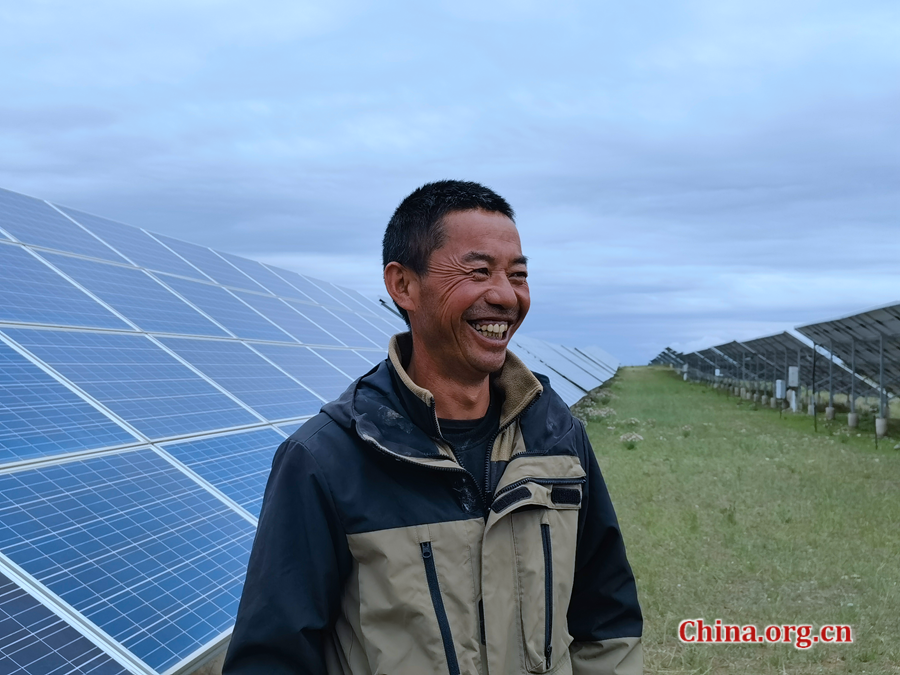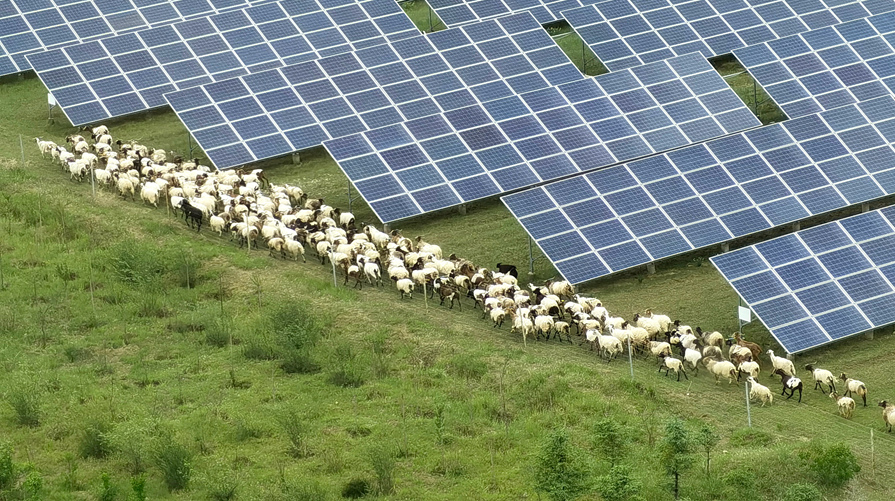For Zhao Guofu, life has taken an unexpected turn. After spending two decades as a migrant worker far from home, he returned to his roots, herding sheep as he once did in childhood, but this time, in his own neighborhood in Gonghe county, northwestern China's Qinghai province.
What greeted him was a landscape transformed. The once arid deserts had given way to rolling pastures, blanketed with rows of glistening solar panels. What he never imagined was that he would not only become part of China's solar energy push, but also thrive because of it.

Zhao Guofu speaks by solar panels in Talatan, Qinghai province, July 1, 2025. [Photo by Zhang Jiaqi/China.org.cn]
From June to October each year, Zhao grazes his sheep across the sun-drenched land, now shared with a sprawling solar farm. In between tending his flock, he picks up odd jobs cleaning the panels, earning extra income. The once-barren highland deserts of Talatan have been transformed into quality pastures, powered by clean energy — and Zhao's life has been transformed along with them.
Go cleaner, and greener
The transformation started in 2012, when construction of China's first 10 million kilowatt-class solar power base initiated in Talatan, an area blessed with nearly 3,000 hours of sunshine annually.
The solar farm built on arid and semiarid land unexpectedly stimulated rapid vegetation growth beneath the panels. Monitoring data shows that the panels helped reduced evaporation by 30%, cut wind speed by half, and boosted vegetation coverage to 80% within just three years.

The solar power base in Talatan, Qinghai province, on July 1, 2025. [Photo by Zhang Jiaqi/China.org.cn]
By the end of 2024, the base had expanded to cover around 420 square kilometers, hosting millions of solar panels with a grid-connected installed capacity of 17.73 million kilowatts. It is now the world's largest photovoltaic (PV) power park by installed capacity.
A win-win way
The cleaning of PV panels, a maintenance must, also contributed to vegetation growth. Data shows that the runoff water helps desert grasslands produce quadruple the fodder while supporting twice as many plant species compared to untreated areas. However, overgrown grass later began shading solar panels and creating fire risks in dry seasons.

A flock of sheep grazes at the Talatan solar power base, Qinghai province, on July 1, 2025. [Photo by Zhang Jiaqi/China.org.cn]
Talatan's PV operators devised an innovative fix: inviting local herders to graze sheep within the facility free of charge. Zhao was one of them who took up the call.
During summer and early autumn, herds freely forage beneath panels, with herders cutting residual grass for winter fodder. This lawnmower system eliminates fire hazards, saves weeding and feeding costs, while manure naturally fertilizes the revitalized soil.
Zhang Jingang, executive vice governor of the People's Government of Qinghai Province, called this an "agrivoltaic grazing" model. "Nature and neighbors both prosper under this agrivoltaic grazing model that pairs environmental protection with economic gains," Zhang explained.
Data from the provincial government shows that this innovative model has benefited 173 previously poverty-stricken villages.
For Zhao, apart from extra pay from solar panel cleaning and grass cutting sometimes, the yearly gross profits for herding sheep averages around 200,000 yuan ($27,900), but he is not sure about this year's net profits yet.
"It depends on how well the grass grows," Zhao explained. "Good vegetation means better profits, but I won't overgraze the sheep either way — protecting the ecosystem comes first."
Industrial synergy
Beyond benefiting local communities, Qinghai's clean energy also has boosted a greener computing power industry.
"Qinghai's strengths in natural resources and energy enable it to generate abundant, cost-effective green electricity and provide reliable renewable power for large-scale computing centers," said the executive vice governor.
Data from the provincial government shows that Qinghai boasted a 95% clean energy share in its 75 million kilowatts of installed power capacity last year, all Qinghai's computing centers are currently powered by over 90% green electricity, and province-wide computing power has grown 40-fold since the beginning of last year.
"Green power attracts green computing with its eco-friendly and cost-effective advantages, while green computing's massive energy demand efficiently absorbs renewable electricity," said Zhu Yuanqing, director of the electricity department of Qinghai's energy bureau.
Meanwhile, a PV industrial line has been established in the province, with considerations for the future: With PV modules expected to retire en masse post-2030, Qinghai has launched China's first industrial-scale recycling line, processing 4,000 metric tons annually while recovering 94.27% of high-value materials like aluminum, glass, and ultra-pure silicon.
"Renewable energy has become Qinghai's most competitive and promising pillar industry," Executive Vice Governor Zhang noted.
For local herders like Zhao, gone are the days of endless nomadic wandering. Now, he can corral his sheep during the day and return home to his wife and son in town by evening. A grin tugs at his lips as he talks about his new life — one where green energy has brought both prosperity and a sweeter, more stable life.


 Share:
Share: 




 京公网安备 11010802027341号
京公网安备 11010802027341号